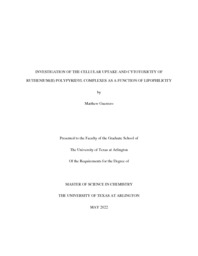| dc.description.abstract | Ru(II) polypyridyl complexes have been one of the focal points of investigation for inorganic anti-cancer drugs, as they are robust enough to remain chemically intact in vivo and many show potent cytotoxicty. In particular, the RPC [Ru(dip)3]2+, where dip is 4,7-diphenyl-1,10-phenanthroline, is noted for its high cytotoxicity (IC50 ~2-5 uM) across a broad spectrum of cancer cell lines and more recently has been implicated as targeting microtubules, which is an unusual target for metal-based drugs. While the cellular uptake for [Ru(dip)3]Cl2 is among the highest seen for RPCs, its solubility in water or buffer is limited and problematic. In order to obtain clear aqueous solutions, it is first necessary to dissolve the complex in DMSO and then dilute it into water (or buffer) and more recent work has shown this solution to be colloidal. In contrast, the RPCs [Ru(bpy)3]Cl2 and [Ru(phen)3]Cl2 are freely soluble in water or buffer but show low cellular uptake and low cytotoxity (IC50 >50 uM). In an effort to examine how the cellular uptake and compartmentalization are affected by the presence of the dip ligand in trischelate ruthenium polypyridine complexes (RPCs), the following series of RPCs were synthesized: +, [Ru(bpy)3]2+ , [Ru(phen)3]2+, [Ru(bpy)2dip]2+, [Ru(phen)2dip]2+, [Ru(dip)2bpy]2+, [Ru(dip)2phen]2+, and [Ru(dip)3]2+ (bpy = 2,2'-bipyridine), with the two heteroleptic bpy complexes being unknown prior to this work. After conversion to the chloride salt, all of the RPCs were assayed for their LogP, cytotoxicity, cellular uptake, and subcellular localization in MCF-7 and H-358 cell lines.
We were able to show a systematic increase in the logP values with the number of dip ligands and homologues with phen ligands generally more lipophilic than those with bpy ligands. Moreover, a substantial difference in the logP values depending on the nature of the aqueous phase was observed. In octanol/water (o/w) measurements, logPo/w values tended to be higher than when measured in octanol/PBS buffer (o/b), which could be a salting out effect, however for [Ru(dip)phen]2+, the value of logPo/w jumps from -1.1 to +1.2 for logPo/b! In this case, the increase is clearly due to more than simple ionic strength effects. Ultimately the aqueous solubility of the RPCs is good for all excepting [Ru(dip)3]Cl2, and the bis dip substituted RPCs [Ru(dip)2bpy]Cl2 and [Ru(dip)2phen]Cl2 showing an optimal combination of aqueous solubility, cellular uptake and cytotoxicity. Investigations into the subcellular localization reveal that these two RPCs also predominantly localize in the cytoskeletal fraction of the cell lysates suggesting they also target microtubule function as their mechanism of action.
In this thesis, Chapter 1 is a review of the RPCs as potential anti-cancer drugs and an update of their role in targeting microtubules. Chapter 2 describes the synthesis and characterization of [Ru(bpy)2dip]2+and [Ru(dip)2bpy]2+ and the measurements of the lipophilicity of these complexes via determination their partition coefficients (LogP) by utilizing the shake-flask method in octanol/water and octanol/buffer. Chapter 3 describes the cellular assays and measurements and correlates these data with the lipophilicity and structural characteristics of the RPCs. | |


